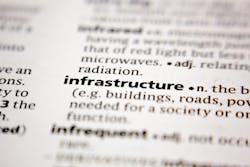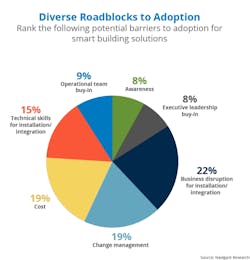“So many functions of our society now rely on connectivity – from public safety, education, transportation to commerce, that it must be regarded as infrastructure.” – Chris Foreman, co-founder and CEO of Marketplace.city
Infrastructure has been at the top of the news cycle lately, and that hasn’t happened for quite some time. While you may not think of it as a trending topic, there is renewed interest in infrastructure, how it is evolving and how it affects us, positively or negatively, in our daily lives.
One of the topics around this revived infrastructure discussion that has made headlines is defining what infrastructure actually means. The Oxford dictionary defines infrastructure as, “the basic physical and organizational structures and facilities (e.g. buildings, roads, power supplies) needed for the operation of a society.” A lot of elements can fit into these broad categories, but this traditional definition is oversimplified. Defining infrastructure for the 21st century requires incorporating the foundational meanings of infrastructure (those terms such as “basic” and “facilities”), while expanding it to also include “access” and “technology.”
Infrastructure in the forms taken from the Oxford definition can be seen in front of us every day, from roads and bridges to water supply and power stations. It’s relatively simple to identify and prioritize these traditional infrastructure projects – the roads and bridges around us are either well-maintained and structurally sound or crumbling and in need of repair or replacement.
Redefining infrastructure to include nationwide digital transformation, renewable energy, carbon emission and healthcare initiatives will take a much higher level of discernment and decision-making. But there are industries making headway in redefining how we view infrastructure.
The Fourth Utility Concept
“Business professionals now consider their telecommunications infrastructure a ‘fourth utility’ that is just as crucial to their employees and clients as electricity, water and HVAC.” – John Dulin, market development, Corning, excerpt from Network Infrastructure: Now the Fourth Utility
The fourth utility concept is an idea known in the commercial building industry that equates network infrastructure to the commonly known utilities of water, gas and electricity. What this concept conveys is that data transmission, communications and connectivity are as important to the functioning of a modern building or city as power and running water.
Today’s structured cabling systems have matured to support multiple business systems within a building, which are typically managed by IT. While the network has long been a vital business system, it is rapidly becoming an occupant experience system, based on user expectations of seamless connectivity and data. That occupant experience system, currently residing within the realm of operational technology, is now migrating from proprietary platforms to network-ready open-IP-based solutions.
It used to be that developers and landlords only needed to supply electricity, plumbing and heating to workplaces, leaving tenants to design their offices to their own technical specifications. Now, commercial builders need to meet rapidly evolving connectivity demands for advanced infrastructures to support everything mentioned above. And more importantly, they must account for new technologies that haven’t been invented yet and future elements that we can’t envision today.
With this dynamic change already taking place, we must take a holistic view of the building technologies, subsystems, and devices that can be supported across a common building platform. Office space providers are being driven to provide telecommunications infrastructure and incorporate sophisticated technologies to stay ahead in a highly competitive market. Where network infrastructure has often been devalued, it is now required to adopt a utility-grade approach that provides infrastructure resiliency in support of information as the fourth utility. As you look across the divisions of the CSI Master Format for Construction, you will find multiple building systems that are either experiencing convergence or have already migrated to the building network. This increase in IoT and network-enabled devices also increases an array of attack surfaces creating physical and logical security vulnerabilities. Where each division is designed, specified and installed, the inevitable question is who will be responsible for ensuring total building system security?
Regardless of how the fourth utility is viewed, as a variety of services and products, or encompassing the entire network infrastructure, it is a concept and an approach to digital transformation that will help to meet what are now considered essential needs for the public. The certainty is that many of the connected devices within cities and buildings are now as important as gas, water and electricity. Which leads to yet another part of the infrastructure equation that must be addressed: the digital divide.
The Digital Divide
“There is a strong consensus that every American household needs to have broadband access.” – Julian Castro, former Secretary of Housing and Urban Development.
During the first iteration of the digital divide several years ago, the issue was around access to computers. Today, the digital divide separating parts of the country is about internet service to enable those computers. According to Pew Research, 40% of schools lack broadband, as do 60% of healthcare facilities outside metropolitan areas. Research from Microsoft puts the number of Americans without broadband somewhere near 163 million.
While broadband access issues clearly exist within urban areas, much of the focus is on rural broadband initiatives like the Rural Digital Opportunity Fund (RDOF). The RDOF is a federal program that plans to disperse billions of dollars to develop broadband in underserved areas in the U.S. over the next decade. President Joe Biden’s proposed infrastructure bill will add an estimated $65 billion more in an effort to deliver broadband to rural America. So, a decade from now, if all goes as planned and the digital divide no longer exists, 400 million Americans will be fully engaged in online activities from school to work to shopping.
This dynamic will deliver an additional upsurge of connected devices and an increase in network convergence, requiring a more robust physical network infrastructure and security measures to support and defend it. We have all experienced convergence throughout the years, with voice and data networks in the 1990s and, more recently, the rapid transformation of video surveillance migrating from analog to IP. We are now at an intersection of convergence where more building subsystems and endpoint devices will become network enabled, from access control and audiovisual to lighting, HVAC systems and more. We have finally reached the tipping point where a common building platform can support multiple subsystems, providing a return on infrastructure investment.
Talk of the digital divide and all the ongoing network convergence is nothing new, but the needs will exponentially increase as we bridge more and more digital divides across the country. Then the discussion turns to how all that data will be transmitted.
Data Centers
“Communications infrastructure will consume 20% of the world’s power by 2025 and enable 20 billion connected devices globally.” – GSMA, The Mobile Economy 2019
Data centers are ubiquitous around the world. Some are small, some are colossal, and all of them take a great deal of energy to operate. The bigger the data center, the more power it needs to function. And the need for always-on energy systems is necessary to maintain uptime.
Data centers measure uptime in what is referred to as the nines. Starting at two nines, or 99%, meaning you’re operating with a downtime of about seven hours a month. Now add four more nines, or 99.9999%, and downtime drops to about three seconds a month – yes, that is only 36 seconds a year.
Where does all that power come from? It’s estimated that soon 20% of the world’s electricity will be consumed by data centers, and it’s a safe bet that large-scale renewable energy initiatives around solar, hydro and/or wind will be coming to fuel the growing datacom need.
But uptime is only one factor in data center operation. Security, especially layered security, must account for both logical and physical security. In the past, the support and management of logical and physical security were siloed, with distinct gaps between ownership and objective. Logical security on account access and admission to the network supported by IT with expectations to thwart cyber punks, hackers and outside entities. Physical security was primarily the domain of facilities with the single intent of securing the premises. Both areas have crisscrossed as a result of digital transformation, IoT adoption, network convergence, as well as cloud/SaaS. The two now have a symbiotic relationship and should be considered in alignment throughout every layer of security.
Smart Buildings
“Part of this idea of smart infrastructure is also about connected buildings that leverage big data for predictive capabilities and energy efficiency.” – Business Insider, The buildings of the future may think for themselves — here’s how they work
The entire concept of “smart” means having the ability to do all of what we’ve explored here so far: cultivate a digital infrastructure, eliminate the digital divide and enable more efficient and powerful data centers. And the focal point for much of this smart technology and infrastructure lies within buildings. From apartment complexes and college campuses to multi-use commercial buildings, the ecosystem of smart buildings is a convergence of technology advancements and mechanical building systems designed to maximize productivity, reduce costs, increase security, promote a healthy environment and enhance the workplace experience.
But the more network-enabled devices you add to a network, the more cyber-attack surfaces are created. The new cybersecurity standards, frameworks and requirements across physical security and operation technology devices should be incorporated in the design and planning stages of a project. Organizations who don’t take advantage of this vital planning stage, may be unable to protect their design intent while cyber-securing physical security devices will fall to a third-party subsystem integrator.
The need for smart building technology is not in question, but according to a Navigant research study on the State of Smart Buildings, there are still several roadblocks that need to be overcome. The biggest factor is the possibility of current business disruption. Halting business to prepare for a future need can be challenging, regardless of how significant that future need may be. The challenge to solutions providers will be to educate potential customers on the reality of inconvenience and downtime and offer strategies to mitigate or minimize the burden for owners and operators to provide a future-ready infrastructure.
The recommendations from the Navigant report gives clear direction for commercial real estate leaders looking to develop a smart building strategy, suggesting the importance of the following:
- Take stock of your buildings’ performance and current operational risks including cybersecurity.
- Understand if and how your tenants would benefit from smart building solutions.
- Assess how your teams are prepared for the introduction of new IoT-driven technology.
Smart Cities
“Fundamental to becoming smart as a city is discovering how to use data to improve city services and quality of life for residents.” – Mayor Andrew J. Ginther
Over the last few decades, the percentage of people living in cities across the world has doubled. Projections show that in the coming decades, almost two-thirds of the global population will live in cities, making smart cities a necessity for residents and visitors alike.
In theory, safety and security applications within the smart city environment should meet real, felt needs for the community and make a positive impact on the citizenry. In reality, one of the most abundant features of a smart city, the omnipresent camera, can be viewed more as “big brother is watching,” than the outgrowth of an expressed need to protect, gather evidence when needed and identify suspects of crimes as well as maintaining the integrity of a police force.
When we drill down into the prime drivers for smart cities, one of the main ones is competition. From an economic development standpoint, a smart city is more than helping the community, it fuels prosperity by bringing in new business and helping residents from relocating elsewhere. This is especially true for the smaller, up-and-coming city trying to differentiate and establish itself with a defined new culture and influence. Smart can be a roadmap for cities to establish themselves with at least a portion of the status held by cities like New York, Los Angeles or Chicago.
That’s a big ask for city officials and planners who are tasked with the challenge of providing:
- Safe and secure environments for growing populations
- Extensive and reliable network connectivity
- Reliable and sustainable power sources
- Modern living and working conditions that include remote access to work and schools
- Seamless and data-driven environments
A smart city approach has become critical for long-term economic sustainability and to improve the community experience overall. According to ABI Research, smart-enabled cities could see incremental growth of over 5% annually and generate $20 trillion globally in additional benefits over the next decade.
The environments we have explored work collaboratively within smart cities. Smart buildings coexist within cities, data centers supply the needed connectivity solutions and the fourth utility approach defines the strategy to allow for the redefined 21st century infrastructure needed to enable smart environments.
Safer. Smarter. More Productive.
Three words sum up what we look for and expect from 21st century infrastructure: safe, smart and productive. From the very beginning, infrastructure has always had safety as a leading objective, from the stone roadway systems that connected Mesopotamia and Egypt providing safe stopovers, to the Roman aqueducts that delivered safe drinking water. Now, physical safety can be dependent on communications infrastructure. Public safety, mass notification, emergency responders and fire control systems all need a robust communications infrastructure to operate efficiently.
“Smart” is such a ubiquitous term today, and smart solutions exist to solve many challenges. But it’s the inventions and innovations that haven’t yet materialized that we need to plan for. A 21st century infrastructure may not be future-proof, but it must be future-ready.
About the Author:
Matt Powers is the vice president of global technology strategy and services at WESCO | Anixter. He leads a Technology & Support Services group of over 70 global engineers who partner with international teams specializing in supporting complex customer applications. He also guides the company’s commercial technology strategy with a team of innovation experts to evaluate and test transformational technologies like IoT, 5G, edge computing, analytics and cybersecurity. In 2014, Matt was recognized as one of the 40 most influential people in the security industry by IFSEC Global.



